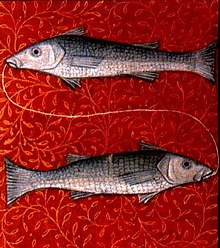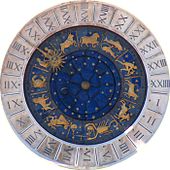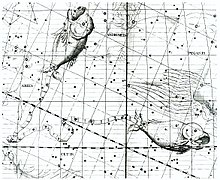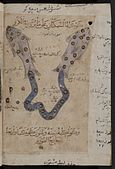Pisces (astrology)
| Pisces | |
|---|---|
 | |
| Zodiac symbol | Fish |
| Duration (tropical, western) | February 19 – March 20 (2024, UT1)[1] |
| Constellation | Pisces |
| Zodiac element | Water |
| Zodiac quality | Mutable |
| Sign ruler | Jupiter (ancient), Neptune (modern) |
| Detriment | Mercury, Ceres |
| Exaltation | Venus, Earth |
| Fall | Ceres |
| Astrology |
|---|
 |
| Background |
| Traditions |
| Branches |
| Astrological signs |
| Symbols |
Pisces (♓) (/ˈpaɪsiːz/,[2] pis'eez;[3] Ancient Greek: Ἰχθύες Ikhthyes) is the twelfth astrological sign in the Zodiac, originating from the Pisces constellation. It spans the 330° to 360° of the zodiac, between 332.75° and 360° of celestial longitude. Under the tropical zodiac the sun transits this area on average between February 19 and March 20,[a][4] and under the sidereal zodiac, the sun transits this area between approximately March 13 and April 13. The symbol of the fish is derived from the ichthyocentaurs, who aided Aphrodite when she was born from the sea.[5]
According to some tropical astrologers, the current astrological age is the Age of Pisces,[6] while others maintain that it is the Age of Aquarius.
Background

While the astrological sign Pisces per definition runs from elliptical longitude 330° to 0°,[7] this position is now mostly covered by the constellation of Aquarius, due to the precession from when the constellation and the sign coincided. Today, the First Point of Aries, or the vernal equinox is in the Pisces constellation.[8][3] There are no prominent stars in the constellation,[3] with the brightest stars being of only fourth magnitude.[9] One star in the constellation, Alpha Piscium, is also known as Alrescha which comes from the Arabic الرشآء al-rišā’, meaning "the well rope,"[10] or "the cord."[9] Ptolemy described Alpha Piscium as the point where the cords joining the two fish are knotted together.[9] The astrological symbol shows the two fishes captured by a string,[11][12][13][14] typically by the mouth or the tails.[15] The fish are usually portrayed swimming in opposite directions; this represents the duality within the Piscean nature.[11][16] Although they appear as a pair, the name of the sign in all languages originally referred to only one fish with the exception of Greek, [17] Bulgarian, Dutch, Latvian, Italian.
In Sidereal astrology, the sun currently transits the constellation of Pisces from approximately March 14 to April 14.[18] Individuals born during these dates, depending on which system of astrology they subscribe to, may be called "Pisceans."[19][2]
Mythology
Divine associations with Pisces include Poseidon/Neptune, Christ, Aphrodite, Eros, Typhon and Vishnu.[20]
In early mythology
"Pisces" is the Latin word for "Fishes."[21] It is one of the earliest zodiac signs on record, with the two fish appearing as far back as c. 2300 BCE on an Egyptian coffin lid.[22]
According to one Greek myth, Pisces represents the fish, sometimes represented by koi fish, into which Aphrodite (also considered Venus)[23] and her son Eros (also considered Cupid)[23] transformed in order to escape the monster Typhon.[3][24][21] Typhon, the "father of all monsters" had been sent by Gaia to attack the gods, which led Pan to warn the others before himself changing into a goat-fish and jumping into the Euphrates.[9] A similar myth, one which the fish "Pisces" carry Aphrodite and her son out of danger, is resounded in Manilius' five volume poetic work Astronomica: "Venus ow'd her safety to their Shape."[23] Another myth is that an egg fell into the Euphrates river. It was then rolled to the shore by fish. Doves sat on the egg until it hatched, out from which came Aphrodite. As a sign of gratitude towards the fish, Aphrodite put the fish into the night sky.[9] Because of these myths, the Pisces constellation was also known as "Venus et Cupido," "Venus Syria cum Cupidine," Venus cum Adone," "Dione," and "Veneris Mater,"[23] the latter being the formal Latin term for mother.
The Greek myth on the origin of the sign of Pisces has been cited by English astrologer Richard James Morrison as an example of the fables that arose from the original astrological doctrine, and that the "original intent of [it] was afterwards corrupted both by poets and priests."[24]
In modern mythology and religion
Purim, a Jewish holiday, falls at the full moon preceding the Passover, which was set by the full moon in Aries, which follows Pisces.[25] The story of the birth of Christ is said to be a result of the spring equinox entering into the Pisces, as the "Savior of the World" appeared as the Fisher of Men. This parallels the entering into the Age of Pisces.[26]
Astrological age

An astrological age is a time period in astrology that parallels major changes in the development of Earth's inhabitants, particularly relating to culture, society and politics, and there are twelve astrological ages corresponding to the twelve zodiacal signs. Astrological ages occur because of a phenomenon known as the precession of the equinoxes, and one complete period of this precession is called a Great Year or Platonic Year[27] of about 25,920 years.
The age of Pisces began c. 1 AD and will end c. 2150 AD.[b] With the story of the birth of Christ coinciding with this date,[28] many Christian symbols for Christ use the astrological symbol for Pisces,[29] the fishes.[30] The figure Christ himself bears many of the temperaments and personality traits of a Pisces,[31] and is thus considered an archetype of the Piscean.[32] Moreover, the twelve apostles were called the "fishers of men," early Christians called themselves "little fishes," and a code word for Jesus was the Greek word for fish, "Ikhthus."[30] With this, the start of the age, or the "Great Month of Pisces" is regarded as the beginning of the Christian religion.[33] Saint Peter is recognized as the apostle of the Piscean sign.[34]
Pisces has been called the "dying god," where its sign opposite in the night sky is Virgo, or, the Virgin Mary.[35] When Jesus was asked by his disciples where the next Passover would be, he replied to them:
Behold, when ye are entered into the city, there shall a man meet you bearing a pitcher of water... follow him into the house where he entereth in.
This coincides with the changing of the ages, into the Age of Aquarius,[36] as the personification of the constellation of Aquarius is a man carrying a pitcher of water.
Associations
A planet's domicile is the zodiac sign over which it has rulership, and the rulers of Pisces,[37] or those associated with Pisceans, are Jupiter,[38] Neptune,[39] and the moon.[40] In esoteric astrology, Venus was considered the ruler of Pisces, and prior to the discovery of Neptune in 1846, Jupiter was said to rule Pisces primarily. Neptune is mostly considered the secondary ruling planet of Pisces today because of the association with the Roman god of water and the sea, Neptune.[22] The detriment, or the sign "opposite" to that which is deemed the ruling planet, is Mercury.[41][39] Venus is exalted in Pisces,[42] while Mercury also falled into Pisces.[41][39]
According to British astrologer Alan Leo, Pisces, along with Scorpio and Cancer, compose the triplicity[43] for water signs.[44][45][46][47][48] The mutability is key to the ever-changing element of water, found in several different forms, much like the transformative aspects found in Christ and Piscean nature. Additionally, these three water signs are considered to be the most fruitful signs,[49][38] who serve a fertilizing function in nature.[50] He also groups Pisces under the "negative pole;"[4] naturally adept to the astral and psychic worlds.[51] This is resembled in the sign for Pisces (♓), which is composed of two half-circles and a band, signifying the dual nature of man in both the physical world and the unseen realm.[52][16] According to 20th century astrologer Robert Hand, the fish facing upwards away from the ecliptic is swimming towards the heavens, or is seeking spiritual illumination. The other fish swims along the ecliptic, concerning itself with material matters.[16] The sign modality for Pisces is mutable. It is part of the group of signs, with Gemini, Virgo, and Sagittarius known as the "mutable signs".
The last sign of the Zodiac, the Pisces symbol has been said to be a representation of the difficulty in extracting the good from that which appears bad.[53] The moral of the symbol for Pisces is said to be that "the severe season has passed; though your flocks, as yet, do not yield their store, the ocean and rivers are open to you, their inhabitants are placed within your power."[c][12][13][14] It is generally considered a feminine sign,[54][55][56] and colors that have been used to represent the Pisces sign are gray[4] or blue gray.[57] The body parts associated with Pisces are the feet,[44][46][58][59] or the toes.[60][61] Likewise, astrologists also associate various diseases of the body with the zodiac, and Pisces' diseases are those of the feet.[62][38] This includes gout,[63] lameness, distempers, and sores.[62] Excess of eating and drinking, as well as poisoning related to the consumption of fish and medicines are also shown in Pisces.[63]
Pisces is classified as a short ascension sign;[64] one which takes a shorter amount of time to ascend over the horizon than the other signs.[65] It is also one of the six southern signs,[48] because it is south of the celestial equator when the sun is in it (no longer true). This results in it being seen in the winter sky in the northern hemisphere.[66] Pisces is also considered a bicorporeal or double-bodied sign,[48] as the astrological sign is composed of two fishes.[67]
Influence

In the arts
Venus exalted in Pisces is representative of divine love in the first canto of Dante's Purgatorio.[68] Pisces is the subject of Luca Della Robbia's 15th century Plate with the Month of February.[69] They are also the subject of one of Elizabeth Barrett Browning's poetic works:[70]
And here fantastic fishes duskly float,
Using the calm for waters, while their fires
Throb out quick rhythms along the shallow air.— Elizabeth Barrett Browning, A Drama of Exile
Modern arts
In the January 1970 edition of the Avengers (No. 72), the supervillain group Zodiac introduced the member "Pisces" whose abilities allowed him to live underwater, which included fins, scales, and gills.[71]
In the 1979 sports fantasy film The Fish That Saved Pittsburgh, the fictitious basketball team the "Pittsburgh Pythons" turn to astrology after a continuous losing streak, and fill the roster with players born under the astrological sign of Pisces. They are reborn as the "Pittsburgh Pisces" and enter into a championship.[72]
Gallery
-
Depicted in 14th century Arabic manuscript, Book of Wonders
-
Appearing in Chartres Cathedral in Chartres.
-
16th century woodcut by Johannes Regiomontanus.
-
Pisces on "Wishing Bridge" in Old Jaffa, Israel.
-
Depicted in a 14th western British Book of Hours
See also
References
Notes
- ^ The duration of Pisces is not distinct; for example, it is also listed as February 19 to March 20,[21] or as beginning on February 20,[2] and ending on March 21.[73]
- ^ There are some discrepancies in when the astrological ages begin and end. The variation in the "Age of Pisces" is said to be from 1 CE until 2150 CE, 498 CE to 2654 CE, and 100-90 BCE until 2680 CE according to the interpretations of Neil Mann, Heindel Rosicrucian, and Shephard Simpson, respectively.
- ^ From the sourcing, there are minor variations of this lesson. For example, in Robert Cross Smith's A manual of astrology, the author claims that the symbolical moral is "the severe season is over; your flocks do not yield their store; but the seas and rivers are open; and there you may take fish in abundance." Summarizing the various sources, it is that the fish will provide sustenance, though the wording is different.
Citations
- ^ Astronomical Applications Department 2011.
- ^ a b c Oxford University Press.
- ^ a b c d O'Shea, Ellsworth & Locke 1920, p. 4638.
- ^ a b c Shoemaker 1904, p. 102.
- ^ http://www.theoi.com/Ther/Ikhthyes.html
- ^ Nicholas Campion, (1988) The Book of World Horoscopes Aquarian Press, Wellingborough ISBN 0-85030-527-6
- ^ Louis 1998, p. 169.
- ^ Ridpath 2001, pp. 84–85.
- ^ a b c d e Star Tales.
- ^ Allen 1899, p. 538.
- ^ a b Leo 1899, p. 39.
- ^ a b Roback 1854, p. 41.
- ^ a b Hutton 1815, p. 368.
- ^ a b Cross Smith 1828, p. 57.
- ^ Mowat, Cooper & MacTavish 1903, p. 34.
- ^ a b c Guttman, Guttman & Johnson 1993, p. 359.
- ^ Allen 1899, p. 338.
- ^ IAU.
- ^ Cainer 1999, p. 82.
- ^ Battistini 2007, p. 62.
- ^ a b c Britannica.com.
- ^ a b Guttman, Guttman & Johnson 1993, p. 357.
- ^ a b c d Allen 1899, p. 339.
- ^ a b The Metropolitan 1834, p. 94.
- ^ Bobrick 2006, p. 9.
- ^ Bobrick 2006, p. 10.
- ^ Spencer 2000, p. 116.
- ^ Freke & Gandy 2001, Myth becomes History.
- ^ Scott 1996.
- ^ a b Freke & Gandy 2001, The New Age.
- ^ Ankerberg 2011, 10.
- ^ Guttman, Guttman & Johnson 1993, p. 360.
- ^ Freke & Gandy 2001, The Greatest story ever told.
- ^ The Open Court 1920, p. 300.
- ^ Guttman, Guttman & Johnson 1993, p. 288.
- ^ The Flaming Sword 1900, Reading the Signs of the Times.
- ^ George 1912, p. 103.
- ^ a b c Cross Smith 1828, p. 69.
- ^ a b c Heindel 1919, p. 81.
- ^ Shoemaker 1904, p. 103.
- ^ a b Leo 2006, p. 23.
- ^ Bobrick 2006, p. 45.
- ^ George 1912, p. 102.
- ^ a b Leo 1899, p. 44.
- ^ Nares 1822, p. 529.
- ^ a b Christmas 1849, p. 51.
- ^ Oxley 1830, p. 292.
- ^ a b c Almanac for the year 1386 1812, p. 74.
- ^ Oxley 1830, p. 289.
- ^ Heindel 1919, p. 119.
- ^ Leo 1899, p. 45.
- ^ Heindel 1919, p. 173.
- ^ Leo 1899, p. 41.
- ^ Lilly 1835, p. 66.
- ^ George 1912, p. 124.
- ^ Heindel 1919, p. 117.
- ^ Whittier Merton 1899, p. 45.
- ^ Heindel 1919, p. 25.
- ^ Shoemaker 1904, p. 17.
- ^ Roback 1854, p. 47.
- ^ George 1912, p. 79.
- ^ a b Partridge 1825, p. 283.
- ^ a b Morrison 1861, p. 64.
- ^ Heindel 1919, p. 97.
- ^ Bobrick 2006, p. 321.
- ^ Heindel 1919, p. 164.
- ^ Heindel 1919, p. 110.
- ^ Bobrick 2006, p. 114.
- ^ Battistini 2007, p. 63.
- ^ Allen 1899, p. 336.
- ^ Marvel Universe Appendix.
- ^ The Fish That Saved Pittsburgh.
- ^ Carey & Perry 2003, p. 308.
Sources
- Allen, Richard Hinckley (1899), Star-names and their meanings, G. E. Stechert, OCLC 1285139
- Almanac for the year 1386, C. Stower Hackney, 1812, OCLC 500148918
- Ankerberg, John (2011), The Facts on Astrology, ISBN 9781937136154
- The Astrologer's Magazine, vol. 5, 1895, OCLC 24090541
- Astronomical Applications Department (2011). Multiyear Computer Interactive Almanac. 2.2.2. Washington DC: US Naval Observatory.
{{citation}}: Invalid|ref=harv(help) Longitude of Sun, apparent geocentric ecliptic of date, interpolated to find time of crossing 0°, 30°.... - Battistini, Matilde (2007), Astrology, Magic, and Alchemy in Art, Getty Publications, ISBN 9780892369072
- Bennet, Jeffrey; Donohue, Megan; Schneider, Nicholas; Voit, Mark (2007), The cosmic perspective (4th ed.), San Francisco, California: Pearson, Addison-Wesley, ISBN 0805392831
- Bobrick, Benson (2006), The Fated Sky: Astrology in History, Simon & Schuster, ISBN 9780743268950
- Cainer, Jonathon (1999), The Complete Book of the Zodiac, Sterling Publishing Company, Inc., ISBN 9780806959221
- Carey, George W.; Perry, Inez Eudora (2003), Zodiac, Kessinger Publishing, ISBN 9780766138063
- Christmas, Henry (1849), The cradle of the twin giants, science and history, vol. 1, OCLC 2784057
- Cross Smith, Robert (1828), A manual of astrology, or the book of the stars, OCLC 243960206
- The Flaming Sword, vol. 15, Guiding Star Publishing House, 1900, OCLC 10327872
- Freke, Timothy; Gandy, Peter (2001), The Jesus Mysteries: Was the "Original Jesus" a Pagan God?, Random House Digital, Inc., ISBN 9780609807989
- George, Llewellyn (1912), Astrological gleanings, Llewellyn publishing Co, OCLC 33185159
- Guttman, Ariel; Guttman, Gail; Johnson, Kenneth (1993), Mythic Astrology: Archetypal Powers in the Horoscope, Llewellyn Worldwide, ISBN 9780875422480
- Hansson, Sven Ove; Zalta, Edward N. (3 September 2008), Science and Pseudo-Science, Stanford Encyclopedia of Philosophy, retrieved 6 July 2012
- Hartmann, P.; Reuter, M.; Nyborga, H. (May 2006), "The relationship between date of birth and individual differences in personality and general intelligence", Personality and Individual Differences, 40 (7), doi:10.1016/j.paid.2005.11.017
- Heindel, Max (1919), Simplified Scientific Astrology: A Complete Textbook on the Art of Erecting a Horoscope, with Philosophic Encyclopedia and Tables of Planetary Hours (4th ed.), Rosicrucian Fellowship, OCLC 36106074
- Hutton, Charles (1815), A Philosophical and Mathematical Dictionary, OCLC 557643793
- Leo, Alan (1899), Astrology for all: to which is added a complete system of predictive astrology for advanced students, L.N. Fowler & Co, OCLC 796904382
- Leo, Alan (2006), Practical Astrology (3rd ed.), Kessinger Publishing, ISBN 9781428600362
- Lilly, William (1835), Richard James Morrison (ed.), An introduction to astrology, rules for the practice of horary astrology, OCLC 25980063
- Lilly, William (2005), Christian Astrology, vol. 1, Cosimo, Inc., ISBN 9781596054103
- Louis, Anthony (1998), Horary Astrology Plain & Simple: Fast & Accurate Answers to Real World Questions, For Beginners Series, Llewellyn Worldwide, ISBN 9781567184013
- The Metropolitan, vol. 10, James Cochrane, 1834, OCLC 58892017
- Morrison, Richard James (1861), The hand-book of astrology: containing the doctrine of nativities, in a form free of all mystery; by which a man may calculate his own nativity and learn his own natural character and proper destiny, vol. 1, Berger, OCLC 60461668
- Mowat, J. Gordon; Cooper, John Alexander; MacTavish, Newton (1903), The Canadian Magazine of Politics, Science, Art and Literature, Ontario Publishing Company, Limited, OCLC 1553181
- Nares, Robert (1822), A glossary; or, Collection of words, OCLC 5730657
- Carus, Paul, ed. (1920), The Open Court, vol. 34, The Open Court Pub. Co., OCLC 1761311
{{citation}}: Cite has empty unknown parameter:|1=(help) - Ormsby, Frank Earl (1893), The law and the prophets, A.L. Fyfe, OCLC 31898638
- O'Shea, Michael Vincent; Ellsworth, Decatur Foster; Locke, George Herbert (1920), The world book: organized knowledge in story and picture, vol. 8, W.F. Quarrie & Co, OCLC 707067037
- Oxley, Thomas (1830), The celestial planispheres, or astronomical charts, OCLC 562440337
- Partridge, John (1825), The astrologer's pocket companion and general magazine, Scientific Press, OCLC 13371093
- Ridpath, Ian (2001), Stars and Planets Guide, Princeton University Press, ISBN 9780691089133
- Roback, Charles W. (1854), The mysteries of astrology and the wonders of magic, OCLC 609243056
- Scott, John P. (1996), The Four Gospels, Health Research Books, ISBN 9780787307516
- Shoemaker, Mabel (1904), Astrology, Penn Publishing Company, OCLC 4936191
- Spencer, Neil (2000), True as the Stars Above, London: Victor Gollancz
- Whittier Merton, Holmes (1899), Heliocentric Astrology: Or, Essentials of Astronomy and Solar Mentality, D. McKay, OCLC 6051760
- Zarka, Philippe (2011), "Astronomy and astrology", Proceedings of the International Astronomical Union, 5 (S260), doi:10.1017/S1743921311002602
Online sources
- Pisces, Britannica.com Inc., retrieved 13 December 2012
- Constellation of Pisces, International Astronomical Union, retrieved 4 December 2012
- Astronomical Pseudo-Science: A Skeptic's Resource List, Astronomical Society of the Pacific, retrieved 7 December 2012
- "The Fish That Saved Pittsburgh", Plot Summary, Imdb, retrieved 1 January 2013
- Pisces, Marvel Universe Appendix, retrieved 22 January 2013
- Pisces, Oxford University Press, retrieved 13 December 2012
- Ridpath, Ian, "Pisces the fishes", Star Tales, retrieved 8 December 2012
External links
 The dictionary definition of Pisces at Wiktionary
The dictionary definition of Pisces at Wiktionary Media related to Pisces at Wikimedia Commons
Media related to Pisces at Wikimedia Commons Quotations related to Pisces at Wikiquote
Quotations related to Pisces at Wikiquote- Pisces Zodiac Sign
- Warburg Institute Iconographic Database (over 300 medieval and early modern images of Pisces)










